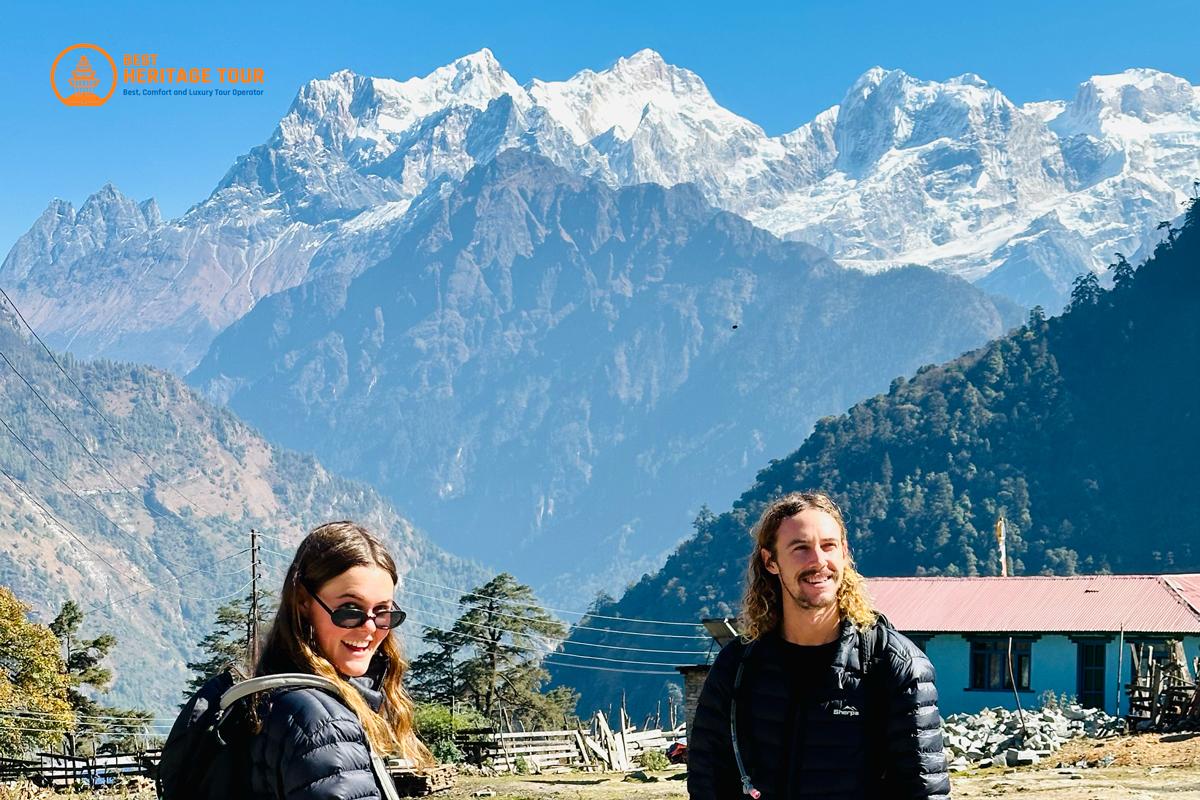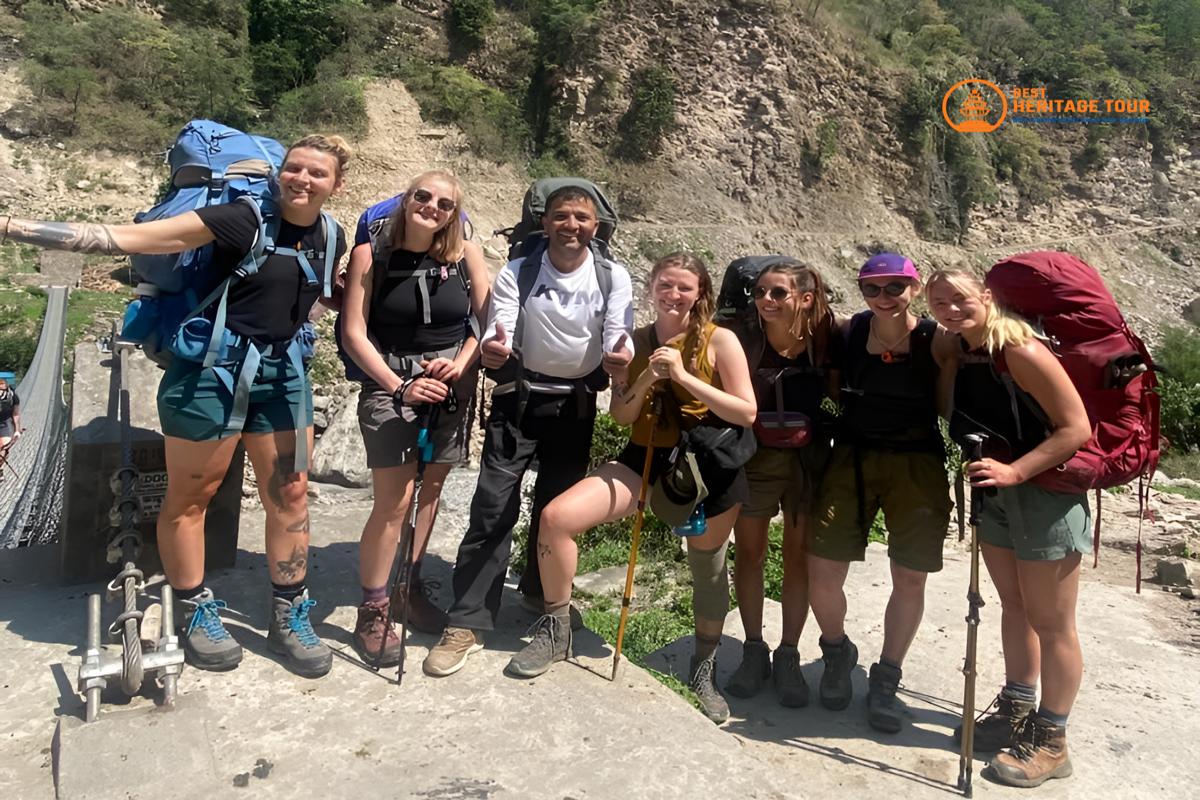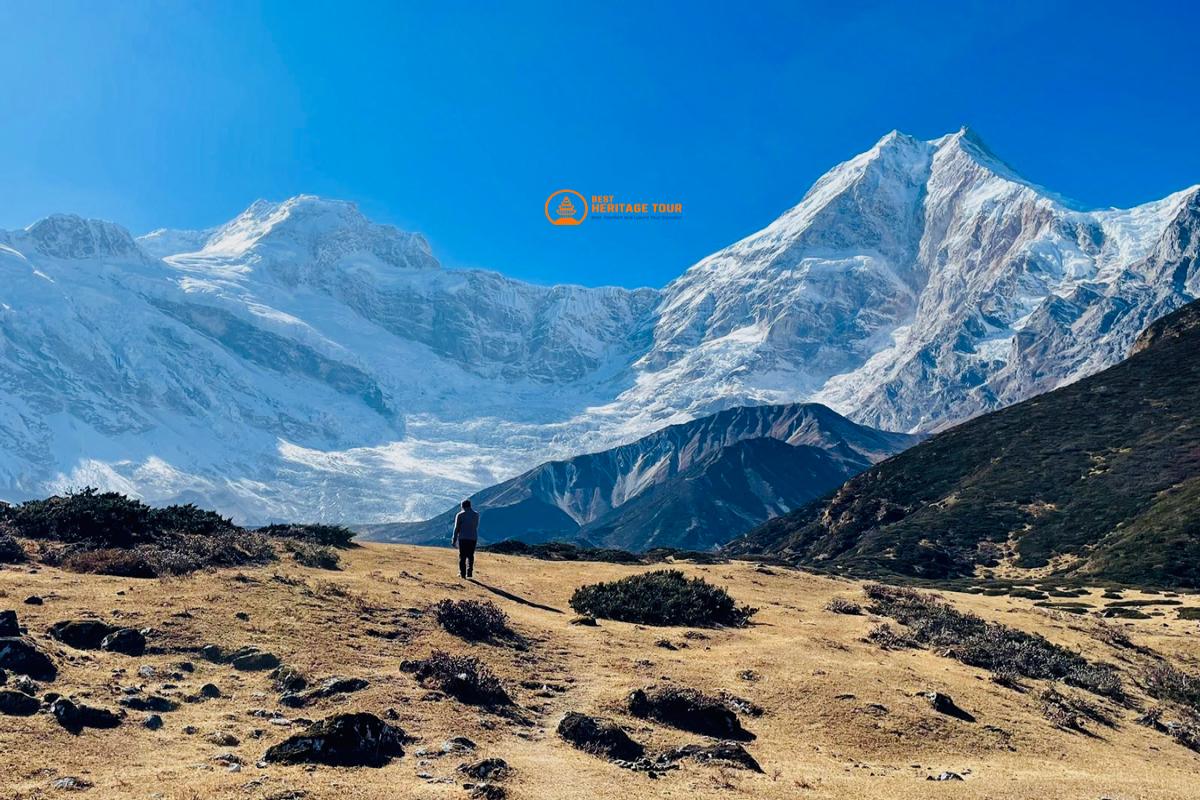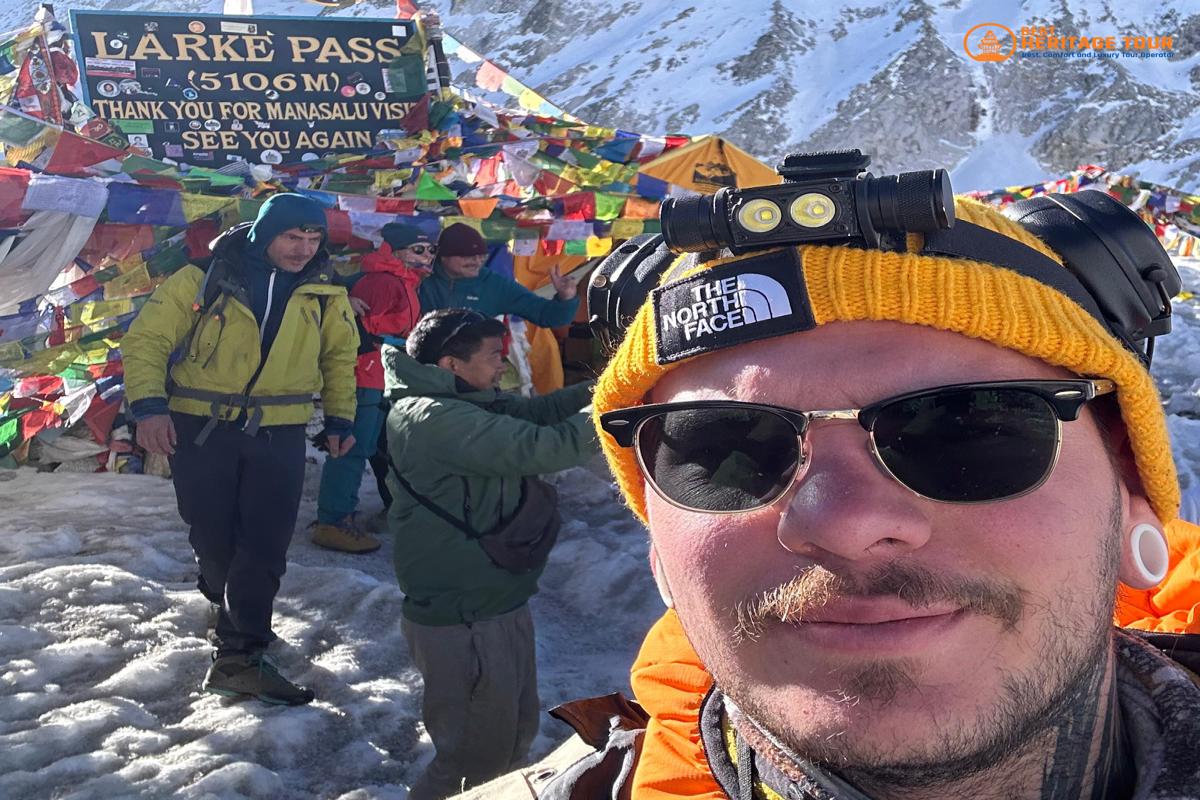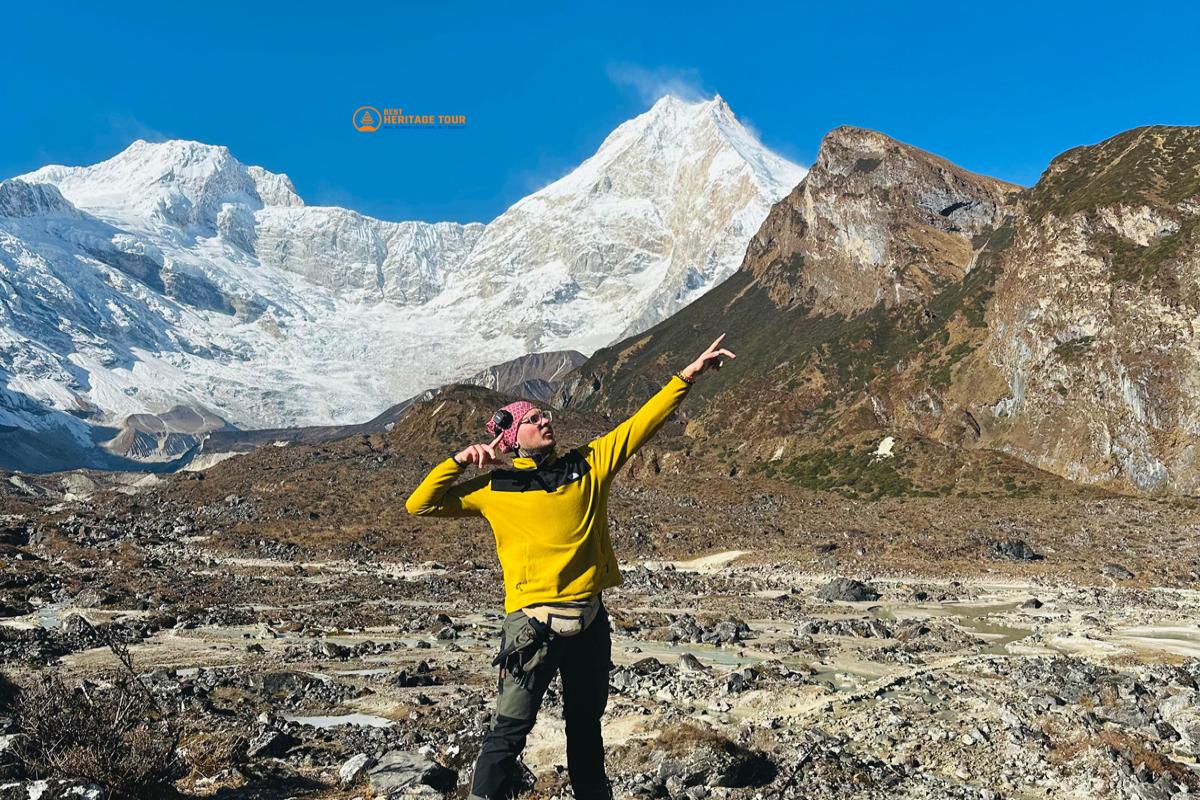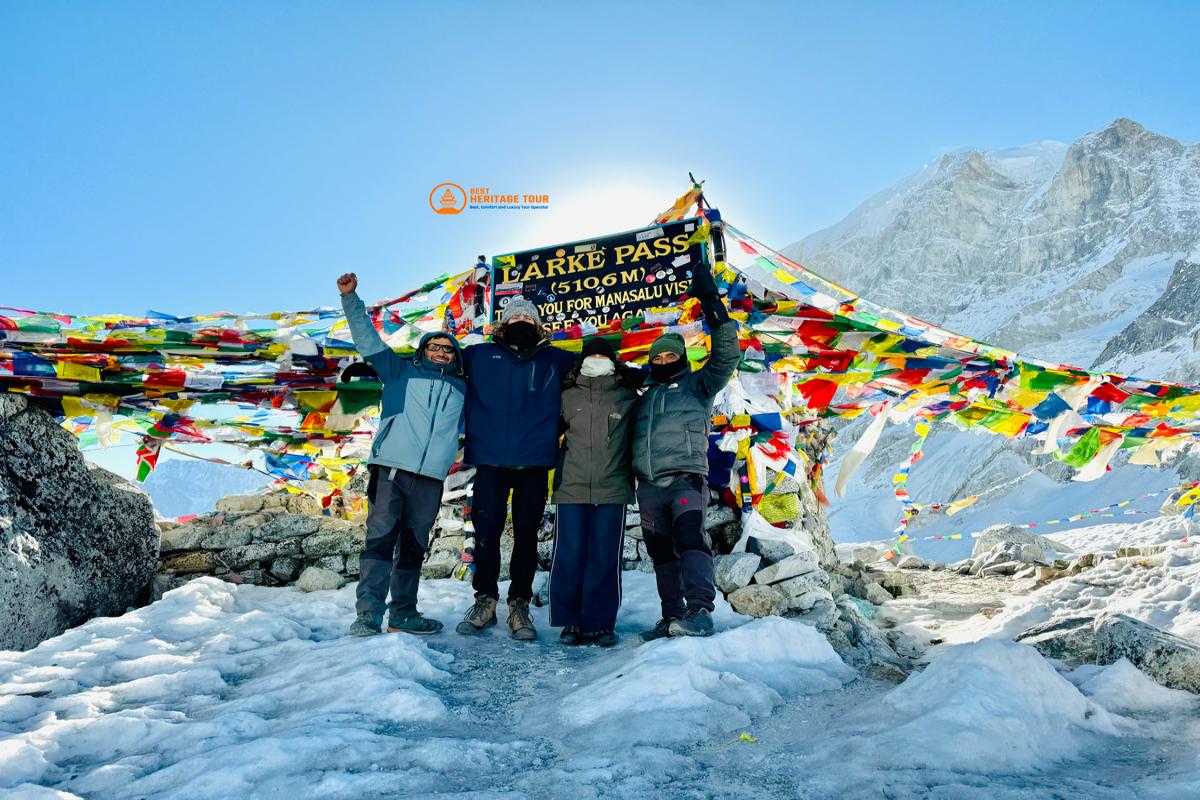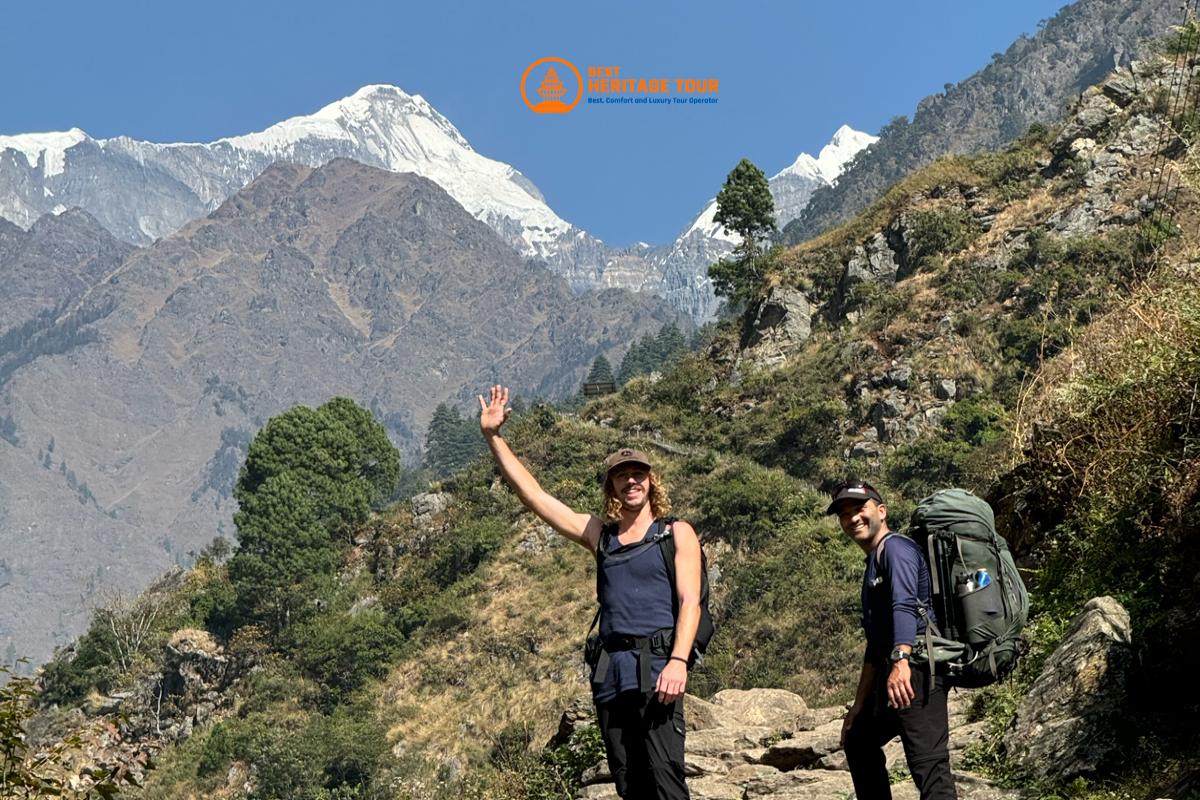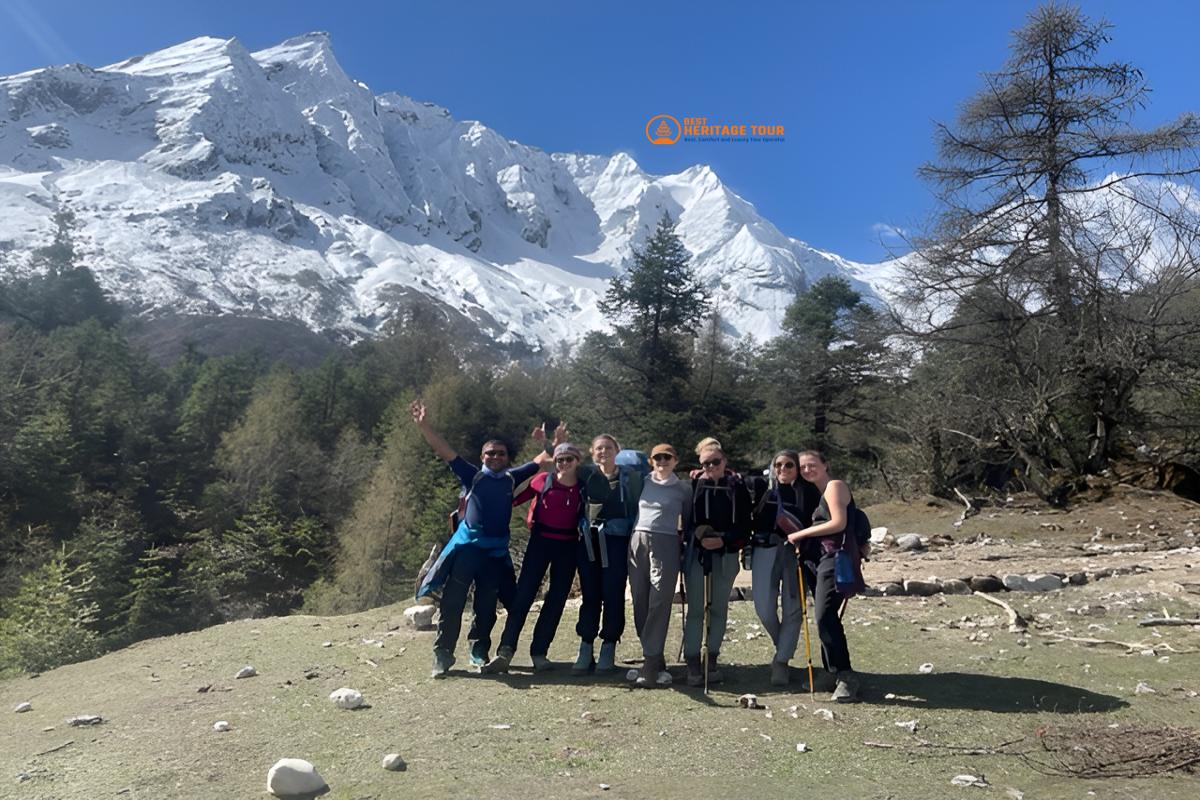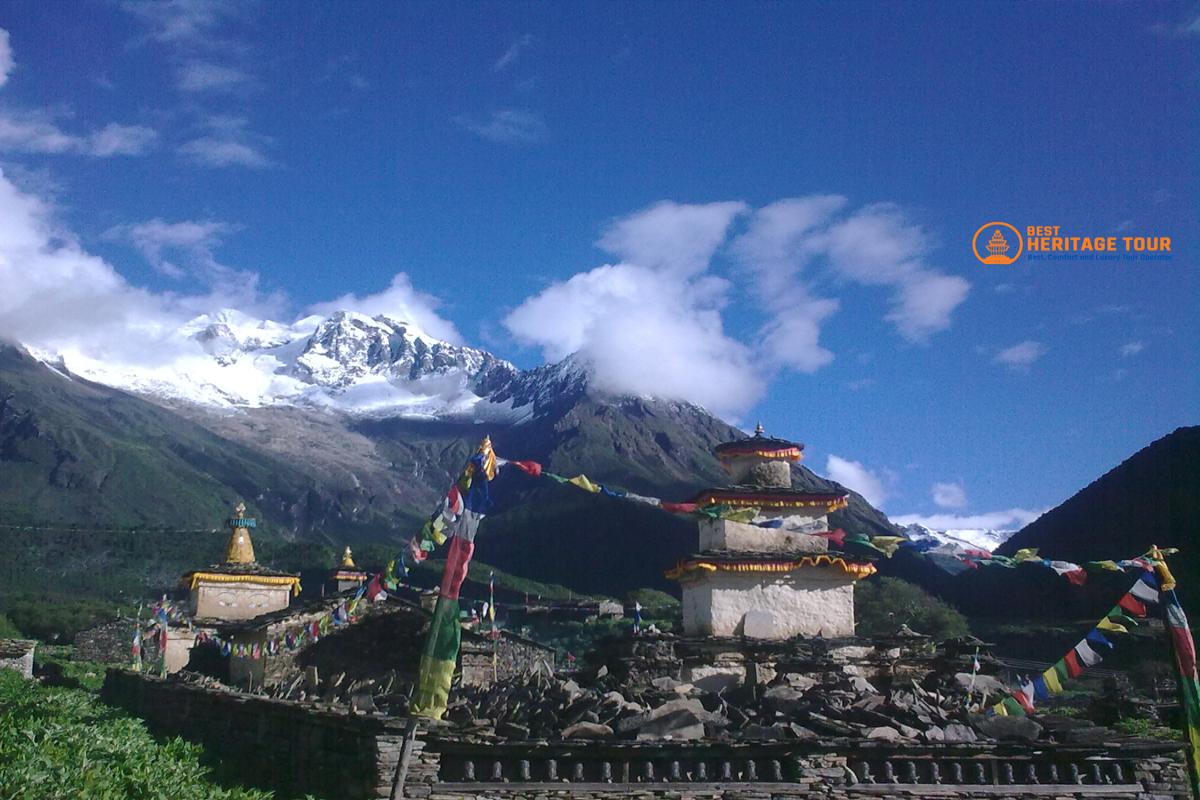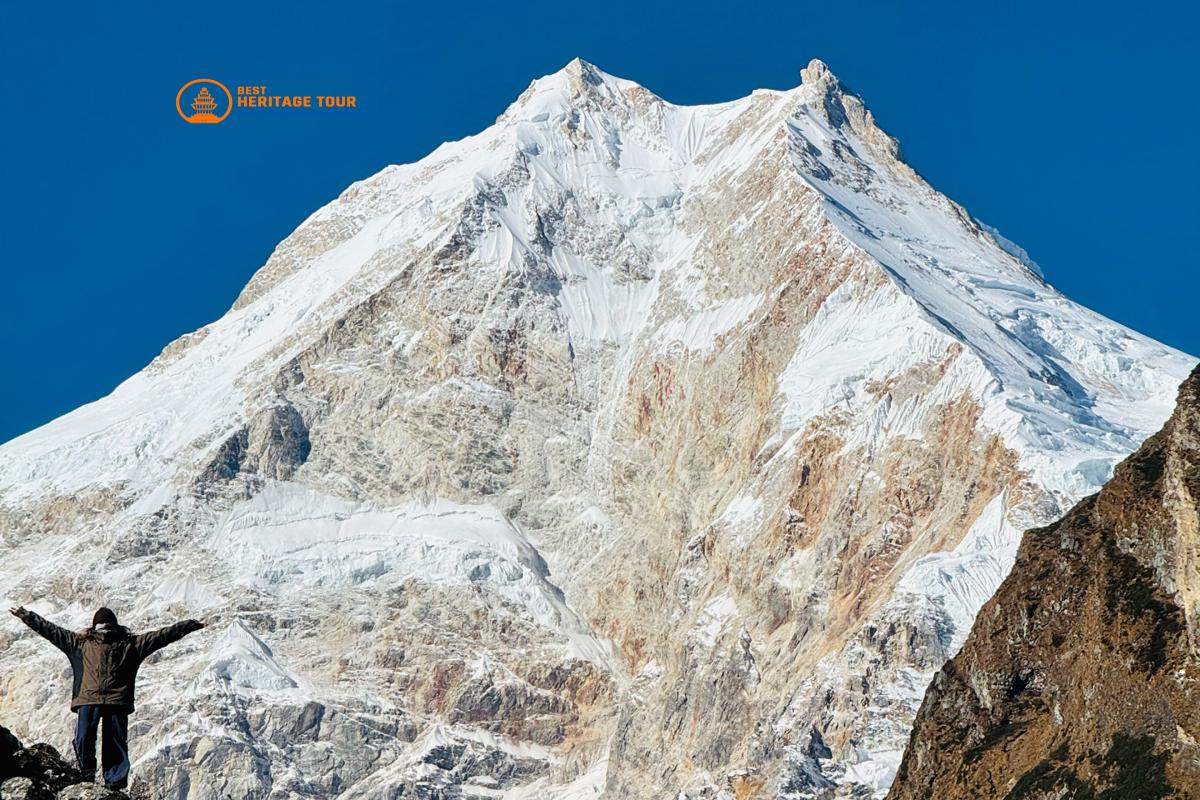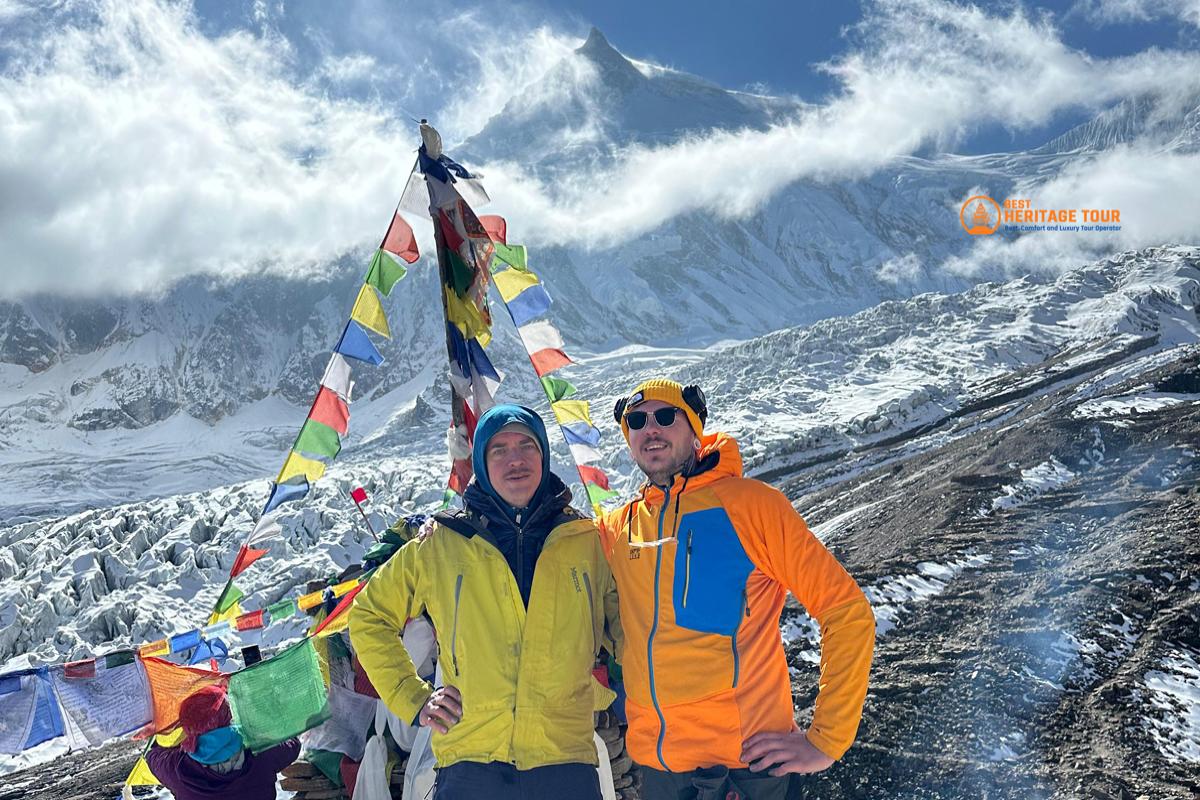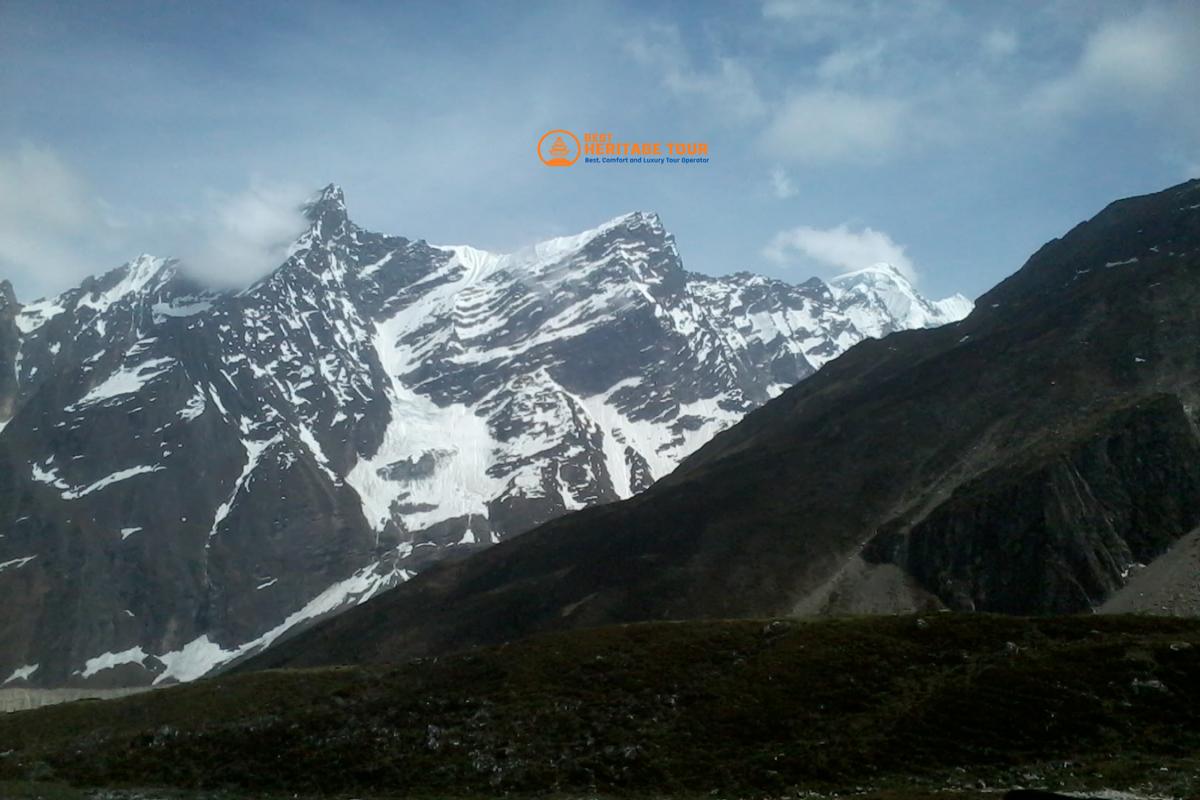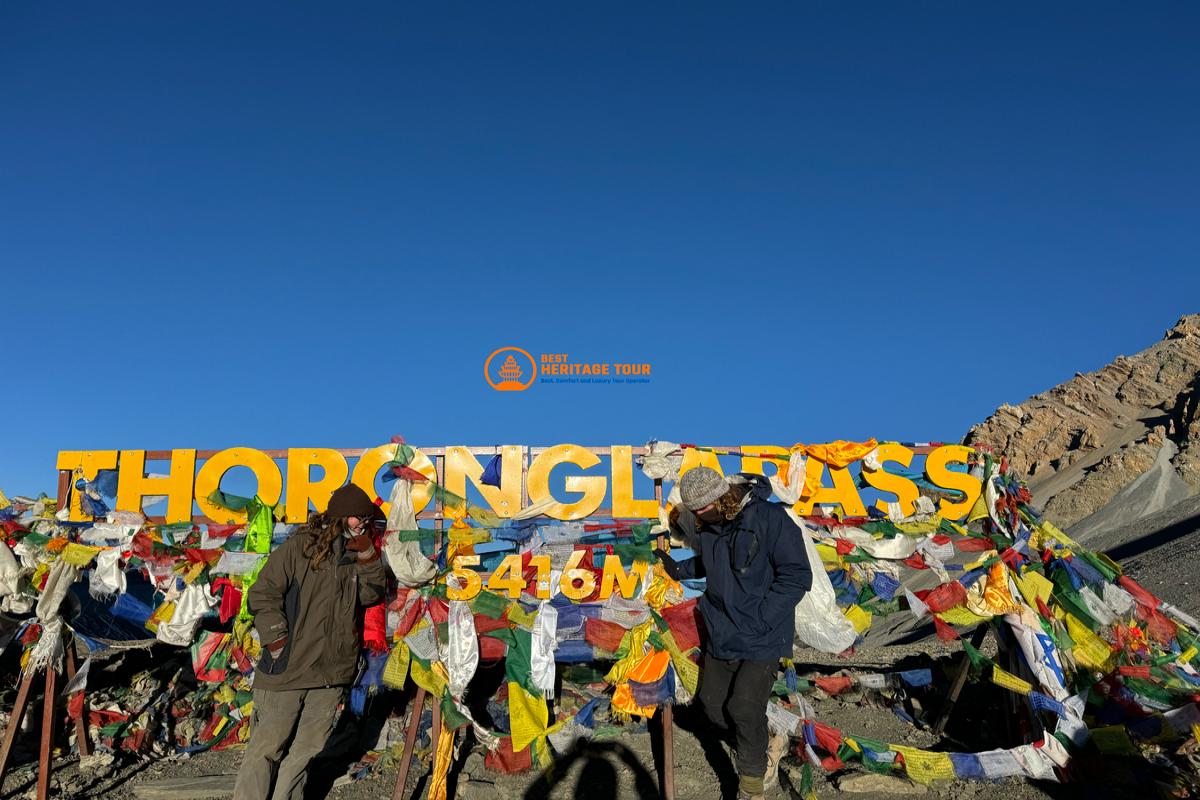Manaslu Tsum Valley Trek - 19 Days
Insight on Manaslu Tsum Valley Trek
Tsum Valley and Manaslu Circuit Trekking takes you around Mount Manaslu, the 8th highest mountain in the world, crossing Lalkiya La Pass (5,106m) and passing through several traditional villages and sacred Buddhist sites. You will also visit Tsum Valley, which is located within the Manaslu Nature Reserve and is home to the indigenous Tumba community.
Trip at a Glance
Key Highlights of the Tsum Valley & Manaslu Circuit Trek
- Scenic drive from Kathmandu to Sotikhola
- Mu Gompa and Lungdang Gompa in Tsum Valley
- Milarepa Piren Phu Cave (Pigeon Cave) is the most revered cave in Tsum Valley.
- Dephyudonma and Rachen Monastery – the oldest monastery in Tsum Valley
- Hike around Mount Manaslu (8,163 meters), the 8th-highest mountain in the world
- Trip to Lake Birendra, Punhyen Glacier, or Mount Manaslu Base Camp during a rest day in Samagaun
- Magnificent views of glaciers, lakes, rocks, and mountains - many views on the Nepal-Tibet border including Manaslu, Himchuli, and Ganesh
- Crossing Larkya La Pass (5,106 meters), one of the longest passes in the Himalayas
- A unique blend of cultures of the Nupuri and Gurung peoples of Tibet
- Ancient Buddhist pagodas, monasteries, and Tibetan lifestyle
- Less crowded roads
- Ancient trade routes to Tibet
Benefits of trekking with Best Heritage Tour
- Free airport transfers between Tribhuvan International Airport and your hotel by private vehicle
- Easy booking and reservation system
- Various communication options available (email, WhatsApp, Facebook, WeChat, Viber, Skype, Zoom).
- Online trip briefing after booking confirmation
- 24/7 phone contact: +977-9810043046, +977-9851149197
- Simple payment system.
- Free excess baggage check at Best Heritage Tour Store during the trek
- A pulse oximeter is utilized to assess blood oxygen saturation levels at elevated altitudes, facilitating the early identification of altitude sickness.
- First aid kit.
- Please bring a sleeping bag and a down jacket if you do not have one.
Online Trip Briefing
The online briefing will clear all your doubts about the hike, including what you need to bring (equipment checklist), itinerary details, and precautions on the trail. After you have booked, we will email you the date and time available for the trekking briefing, and once we receive all the necessary documents, we will conduct the trekking briefing online.
Detailed Exploration of the Manaslu Tsum Valley Trek
Depart from Kathmandu for the Manaslu Tsum Valley trekking and reach Sotikhola via Arughat. The Manaslu Circular Tsum Valley trekking starts from Sotikhola and climbs the Budhi Gandaki valley through pine and rhododendron forests and crosses the ridge to Lokpa, the entrance to the Tsum Valley.
However, it will take 3 days to reach Lokpa. We start our climb from Sotikhola. On the first day, we stop at Machha Khola, then Jagat, and finally Lokpa.
The hike continues through the Manaslu and Tsum valleys. From Lokpa, we trek to Chumling, known for its three monasteries Pango Gumba, Mani Dhungyr, and Gurwa Gumba.
After an overnight stay at Chumling, we continue to Chhokangparo via Domje (the largest village in Tsum Valley), which is famous for its spectacular views of Himalchuli and Ganesh Himal.
The Manaslu Circuit Tsum Valley Trek continues from Chhokangparo through the refreshing bamboo and exotic rhododendron forests of the lowlands into the upper Himalayan valleys. The higher route passes through tranquil alpine clearings and harsh alpine deserts.
On the way from Chhokangparo to the Nile, you will also visit Piren Phu Cave, the most sacred cave in the region. From the Nile, you will ascend to Mu Gompa, the highest point of the Tsum Valley Trek. After reaching Mu Gompa, you will head back to Lokpa and proceed with the Manaslu Circuit Trek.
From Lokpa we hiked west to reach Deng where we spent the night. On the way, we pass the villages of Ghap, Rana, and Bhiphedi. The next stop on this hike is Namrung village. The residents of Namrung have Tibetan heritage.
The next day we leave Namrung and head towards Sama Gaun. On the way, we come to Lho, a place filled with an entrance gate made of Mani walls and several Buddhist gompas. After Lho, hike to Sama Gaon via Shyala village, known as Sama Gaon Monastery.
Spend a day at Sama Gaon for acclimatization. On this day you can visit Manaslu Base Camp, Birendra Lake, and Pungyen Gompa.
Larkya La pass is not far from Sama Gaon. It is only a one-day trek to Dharmasala. The next day, you will hike from Dharmasala to Bhimtang early in the morning. Along the way, you will pass Larkya La pass (5,160m).
This pass is famous for its breathtaking views of Cheo Himal, Kanguru, Himlung Himal, and Annapurna II and is one of the longest passes in the Himalayas.
Once you reach Bhimtang, this trek is nearing its end. You will trek from Bhimtang to Goh and then to Tal. From Tal, take a bus or jeep to Besisahar, where you can board a bus to Kathmandu.
Trekking through the Tsum Valley around Manaslu is sure to be an unforgettable experience. For more details, see the "Manaslu Tsum Valley Trek Itinerary" section below.
Itinerary
After an early breakfast, start your journey with a drive along the Prithvi Highway, west of Kathmandu. The scenic drive will take you through views of terraced fields, rushing rivers, beautiful villages, and dense forests. Travel across the Trishuli River to Dhading Bensi, then head to Arughat. Passing through picturesque villages, we continued north through Dorandi Khola towards Gorkha. The road offers breathtaking views of Manaslu and Ganesh Himal. But our destination is still a 2-hour drive from Arughat to Soti Khola.
We continue northwards through the low valley and ascend the picturesque and densely forested Budhi Gandaki valley with occasional glimpses of the majestic peaks of the Himalayas. The path goes through many small villages before the valley opens up. On the other side of the valley, you can see a large river flowing into the Budi Gandaki River. Continuing the journey, you will reach the beautiful village of Lapubesi (880 m). From Lapubesi, you will descend a winding road to reach Macha Khola.
Cross the Taro Khola River and walk upstream to Khola Beni. The route takes you through a dramatic gorge with waterfalls and rock formations formed by several landslides. After crossing a bridge, you will reach the small village of Kholabesi and then the natural hot springs of Tatopani (Tatopani means hot water in Nepali).
From the hot springs, you will take a different route and cross the Budi Gandaki River on a suspension bridge. You will then hike past the landslides and reach the village of Dobhan. From Doban, cross the suspension bridge over the Yar Khola River and climb the stone steps to Tado Balyan and the charming village of Jagat. Jagat is the access point to the Manaslu Nature Reserve, and you will register your permit at the police checkpoint at Jagat.
Enter the Manaslu Restricted Zone by climbing the ridge to Salleri. Walk along the riverbank and cross the Budi Gandaki River on a long suspension bridge. As you continue hiking, the valley widens towards Philim. After Ekle Bhatti the path splits, one leads to Tsum and the other to Manaslu.
Hike through several villages to Lokpa. The river narrows and you can see the confluence of the Shar River from the Tsum Valley. Hike on the right side of the Tsum Valley to reach Lokpa village, the first village in the Tsum Valley with a clear view of the Manaslu range. This is a completely hidden valley blessed centuries ago by Padmashamva (one of the founders of Tibetan Buddhism). From Lokpa village, you can enjoy breathtaking views of Himalchuli and Bodha Himal.
After breakfast, we start our hike from Lokpa village, a rough trail that leads to the entrance of Tsum Valley. On a clear day, the trail that connects Lokpa to Chumling offers breathtaking views of Baudha Himal (6,672 m) and Ganesh Himal VI.
Our route first descends into the Lungwa River valley and then climbs up through a dense subtropical forest of rhododendrons and pine trees. There are no villages situated between Lokpa and Chumling. We cross Syar Khola to reach Chumling village. At the top of Chumling, there is a monastery with a great view of Ganesh Himal. Chumling has a clinic and three other monasteries: Panago Gumba, Mani Dhungyur and Gurwa Gumba.
Today we enter the upper valley of the Himalayan interior. The trail follows the Siar River to Domje, the largest town in the Tsum Valley. From Domje, you continue uphill to Chhokangparo. On a clear day, Chhokangparo offers beautiful views of Himalchuli and Ganesh Himal. At Chhokangparo, you will have the opportunity to experience the hospitality of the local people (Tibetan "Tsombo") as well as Tibetan Chiya (butter tea) and local cuisine.
Today you will walk a relatively short distance. The Nile, west of Shikar Khola, is about a 20-minute walk from Chhule, the last village in the northern Upper Tsum Valley. When you reach Ngakyu Leru, you will notice that people are farming as the land is fertile.
After passing through Lamagaon, you will reach the Pilen Phu cave of Saint Milarepa, where his footprints are said to remain in the rock. Pilen Phu (Pigeon Cave) holds great religious significance and is considered one of the most revered caves in Tsum Valley. The rock cave has two kuribohs stuck inside. Richly painted Buddhist murals, superb stone-carved art scriptures, long prayer flags, and important Buddhist paper scriptures make Pilen Phu cave one of the most important socio-cultural treasures in the valley. You will then cross a suspension bridge over the Sia River and continue trekking through several villages until you reach the Nile.
A short walk from the Nile along the western bank of the valley near the Tibetan border will bring you to Mu Gompa, the highest point of the Tsum Valley hike. You will walk across yak grazing lands and pass through dry, rugged terrain, which is typical of treks in the trans-Himalayan region. Mu Gompa monastery is lined with chortens and offers beautiful mountain views. We also have the chance to visit Dhephu Doma Gompa, one of the oldest monasteries in Tsum.
From the Gompa, we start our descent. We descend to Rachen Gompa, then to Chhule, and reach Phurbe. Lachen Gompa sits on the Nepal-Tibet border, encircled by towering mountains. But our destination for the day is through the forested area and finally reaches Chhokangparo.
The descent from Chhokangparo Paro continues until we reach Go. We crossed the suspension bridge near Go and continued hiking to reach Rainjam village. We leave Rainjam village descend into Tsum Valley and finally reach our destination for the day, Chumling.
Today's journey should be easier as we leave Chumling and continue downhill. We walked along the banks of Shair Khola to reach Lokpa village. On a clear day, you may pass large herds of sheep and goats on the way.
The road to Lokpa descends over the Budhi Gandaki River on a sturdy bridge, enters a narrow gorge, and then climbs the valley with a gentle uphill climb. We cross the river on a suspension bridge to Nupuri, then hike through a bamboo forest to reach the Gurung village of Deng (1860 m above sea level).
From Deng, climb to Rana village (1910m) and continue to Bhiphedi (2130m). The path first meanders through the valley gorge and crosses the Serang Khola River before reaching Gap (2160m). Leaving Gap, the valley becomes steeper as a long climb continues through bamboo and rhododendron forests. After several wild river crossings, you reach Namrung village, the access point to the Nupuri region. The inhabitants of Namrung are of Tibetan descent.
We leave Namrung and pass many entrance gates of the Mani Wall, several Buddhist gompas, and several villages. Then the valley opens up and our route passes the village of Shaw. This village is known for its large yak population and its amazing views of Manaslu (8,163 m) and Manaslu North (7,157 m).
A perfect day to enjoy the amazing mountain views. To arrive at Sama Gaon (3,530 m), proceed along the right bank of the river, which offers splendid vistas of Peak 29. After a few hours of climbing through the forest, you reach the village of Shala, from which you can see the Punggi range, Manaslu, and Himalchuli mountain ranges. The villagers of Shala depend on yak, potato, and barley to survive in this decidedly alpine region.
As you hike, you can see Ganesh Himal to the east and Himalchuli and Manaslu to the south. As you look down, you'll spot two rows of houses that make up the heart of Sama Gaon. Opposite Sama Gaon is the famous Sama Gaon Monastery. From here the Tibetan border is very close. We stop at Sama Gaon for 1 day for acclimatization.
To ensure proper acclimatization we will spend 1 day at Sama Gaon for recovery. Sama Gaon is located near Manaslu Base Camp. In this village, there are thousands of mani stones with Buddhist writings and carvings. The women here wear beautiful silver spoons as jewelry.
Today is a rest day, but you can take an optional tour to explore the surrounding glacial deposits and visit Birendra Lake and Pungyen Gompa. The round trip to Manaslu Base Camp takes about 8 hours. It's a rewarding journey with stunning views of the Manaslu Glacier and the beautiful Birendra Lake. If you want to explore Sama Gaon and take it easy, check out Pungyen Monastery, which is situated below the eastern wall of Manaslu. Further up the village, there is a cave gompa and hot springs.
We leave Sama Gaon early in the morning and head towards Samud. Our hike takes us through terraced fields, along the old walls of Mani, across the wooden bridge of Budi Gandaki, and gradually ascends into the Samud valley. Another Mani wall marks the beginning of the climb to the Larkya La pass. We crossed two rivers and witnessed the Larkya glacier. Then we circle the Sarka Khola valley and climb again, reaching a stone guesthouse (4,450 meters). This place is not a lodge, but a resting area known as Dharmasala, or Larkya La Fedi. Today we enjoyed a magnificent view of the Larkya glacier and the imposing Mount Manaslu. We rest at Larkya La Fedi and prepare to cross the Larkya La pass the next day.
We leave Dharmasala early in the morning as this will be the longest and most difficult part of the trek. We need to cross Larkya La Pass (5,160m) before the wind picks up at the pass. The trail starts with a gentle climb over a moraine. A brief decline leads to the lake, followed by a rugged and indistinct path traversing a steep, grassy incline. We keep moving up the moraine to a ridge marked by two stone piles. From here we can see the prayer flags that mark the pass.
We descend to four frozen lakes and then climb the final steep ascent to the pass, which offers stunning panoramic views of Himlung Himal, Cheo Himal, Kanguru, Minjung, and the mighty Annapurna II. Then the descent begins. The trail follows the top of the moraine westwards, makes a series of steep and rough switchbacks as it crosses the moraine, then descends gently over loose gravel to another grassy moraine at 4,450 m. The path becomes easier and reaches a small meadow. The valley widens as the trail descends into a large meadow, passing the Mani Wall and a small rest stop marking Bhimtang at 3,590 m.
The trail from Bhimtang crosses a moraine, descends to the source of the Dudh Khola, crosses a wooden bridge, enters a pine and rhododendron forest, and continues to Hompuk (3,430m). The rhododendrons are colorful, and the forest is home to sheep, horses, and monkeys. You can also enjoy panoramic views of Punggi, Manaslu, Manaslu North, Cheo Himal, and Himlung Himal. After a 30-minute descent through the forest, you will reach the Sangore Kharka grassland. Then we cross a landslide and climb steeply up to a ridge with prayer flags. The route finally drops down to the riverbank at Gho (2,575m).
The route is undulating, mostly through fields but occasionally through dense forests. After passing through fields and intermittent rhododendrons and oak forests, we reach the multi-ethnic community of Tillie within an hour. Leaving Tiliye through a stone arch, you cross the Dudu Khola River and follow its banks down through the scrubland. As you hike further, the cliffs of the Marsyangdi Valley become more impressive, and soon you can spot the homes of Dharapani in the distance. You then pass through Tonje village via a wooden bridge and a chorten-shaped arch before crossing a long suspension bridge over the Marsyangdi River to reach Dharapani. However, the trail continues along the sandy banks of the Marsyangdi River until you reach Tharu. The prayer flags, mani wall, and chorten around Tharu indicate that it is a Buddhist village.
In the morning, take advantage of a local jeep or bus to travel from Tal to Besisahar. The journey takes approximately 4-5 hours, passing through several villages, Bhulbhule, and Kudi towns on the way to Besisahar. You should reach Besisahar by 3 pm to catch the last jeep or local bus to Kathmandu. On the way back to Kathmandu, the road follows the beautiful Marsyangdi River, which merges with the Trishuli River on the way east on the Prithvi Highway During the trek, you will encounter verdant landscapes, terrace agricultural fields, and possibly catch sight of snow-capped mountains in the distance.
What is included?
- Travel from Kathmandu to Soti Khola (starting point of the trek) via Arughat and then travel from Tal (endpoint of the trek) to Besisahar and then return to Kathmandu by local bus.
- All standard meals during the trek (19 lunches, 18 dinners, 19 breakfasts).
- Accommodation for 18 days (usually double rooms) at the best tea houses/lodges in the trekking area.
- Government-certified English-speaking Best Heritage Tours trekking guide/leader and porters to carry your luggage. We provide one porter for every two climbers. The weight limit of luggage per climber is 8 kg.
- Guide and porter fees, meals, insurance, salary, accommodation, transport and other necessary equipment
- Special permit for Manaslu and Tsum Valley (with Conservation Area Permit and Annapurna Wildlife Conservation Area (ACAP) Permit Fee)
- Tablets for purifying water to ensure safe drinking.
- Daily provision of snacks, including cookies, alongside a selection of seasonal fresh fruits.
- Rescue measures in complex health conditions
- Souvenir – company T-shirt and cap
- Receive a Best Heritage Tour Appreciation Certificate upon successful completion of the trek
- Farewell dinner in Kathmandu after the end of the hike
What is not included?
- International flight costs.
- Fee for Nepal entry visa at Tribhuvan International Airport.
- Excess baggage charges (up to 8kg per person).
- All lodging and meals in Kathmandu before and after the journey.
- Extra overnight stay in Kathmandu due to early arrival, late departure, or early return from the trek.
- Personal expenses - Shopping, snacks, bottled water for boiling, hot (tea/coffee) and cold drinks, hot showers, alcohol, Wi-Fi, telephone, battery charging fees, laundry, additional porters, etc.
- Personal clothing and equipment.
- Travel insurance covering emergency rescue and evacuation at high altitude (mandatory).
- Gratuities to tour guides and porters.
- Additional expenses or delays due to circumstances beyond our control. Landslides, weather conditions, changes in the itinerary due to safety concerns, illness, changes in government policy, strikes, etc.
- All expenses not mentioned under "Cost inclusions" are excluded.
- All government taxes 13%, SSF, and 10% service charges
Route Map
Equipment
We recommend the following clothing, accessories, and gear list for the Tsum Valley and Manaslu Circuit trek. This is just a reminder list that we have put together for your comfort and convenience. Please note that the luggage weight limit is 8kg so please only bring the essentials when traveling.
Head
- Sun hat or scarf
- Warm hat, padded hat, or broad-brim hat.
- Headlamp with extra battery
Face
- Sunscreen
- Sunglasses with UV protection
- Face/body towel
Hands
- Lightweight gloves
- Thick winter gloves
Body
- Hiking shirt
- Long-sleeved shirt
- Hooded rain jacket
- Fleece jacket
- Lightweight cotton pants
- T-shirt (bring a light woolen one)
- Polypropylene underwear
- Down jacket (rent in Kathmandu)
- Sweater
- Waterproof jacket and pants
Footwear
- Hiking shoes
- Thick woolen socks (bring an extra pair of thick, lightweight socks)
Key Gear
- Backpack or daypack (size depends on whether you use a luggage rack or not).
- Thermos
- Water filter
- Trekking poles
- Sleeping bag (-15 bags is best for high-altitude trekking)
Personal Care Items
- Medium-sized dry towel
- Toothbrush
- Toothpaste
- Deodorizing dental floss
- Biodegradable soap
- Nail clippers
- Small mirror
Personal Accessories
- Money
- Watch
- Mobile phone
- Camera
Extra items
- First aid kit
- Extra passport photo and passport copy
- Notebook and pen
- Binoculars
Trip Info
Why choose Manaslu Circuit and Tsum Valley Trek?
The trekking route through the Tsum Valley offers an opportunity to discover the breathtaking geography and rich cultural heritage of the Manaslu Circuit and Tsum Valley region. This trail is known for its majestic mountain scenery, dramatic landscapes, terraced fields, mystical valleys, Tibetan culture, and Larkya La plateau.
Visit the upper reaches of the Budhi Gandaki River and continue to Mu Gompa (3,700m) and enjoy the magnificent views of Ganesh Himal, Singri Himal, and Boda Himal. The hike takes you over Larkya La Pass (5,106m), the highest point of the hike. Once you reach Marsyangdi River, you will have done a half-circuit tour of the three peaks of Manaslu.
Manaslu region can be considered as the hidden Himalayan treasure of Nepal that is still waiting to be explored. Tsum Valley with its rich cultural heritage and mystical mountaintop monasteries, traditional villages, colorful people, mystical yaks, Mani walls, chortens, vibrant festivals, and historical treasures is the Shangri-La of the Himalayas.
Notice:
Best Heritage Tour requests all our valued clients to spend an extra day in Kathmandu on a weekday (office day) before starting the Tsum Valley and Manaslu Circuit Trek. It takes at least one day to get the Manaslu special permit. The original passport with a Nepalese visa is required for the permit application. This time will also be used for a trip briefing, where we will share important information about your trip and check your luggage (equipment) for any forgotten items. This trekking package includes public bus transportation. For added convenience, you can rent a jeep at an additional cost.
Manaslu Tsum Valley Trek Details
Free Airport Pickup
We provide a complimentary transfer service from Tribhuvan International Airport (TIA). On your arrival at TIA, you will meet a Best Heritage Tours representative with a brochure with your name on it. After you are picked up at the airport, you will be taken to your hotel in a private vehicle. On your return, our representative will escort you from your hotel to Kathmandu airport.
Trekking Briefing
We will hold a trekking briefing online before your arrival in Nepal to provide you with important information about the trek. You will also have a personal meeting in Kathmandu before the start of your trip. During this meeting, your luggage will be inspected to ensure you have all the necessary clothing, gear, and equipment.
Start of the Trek for Tsum Valley and Manaslu Circuit
Arrive in Kathmandu at least 2 days before your trek. Make sure you have plenty of time (working days) before your departure date. You need 1 day to get a special permit for Manaslu trekking. You need a passport with a Nepali visa to obtain this permit. If you were unable to attend the online trip meeting, you can now have a face-to-face trip meeting. On the third day, you will drive from Kathmandu to Soti Khola, the starting point of the hike.
Notice:
The package covers local transportation from Kathmandu to Arughat, then to Soti Khola, and return from Tal to Besisahar, followed by the journey back to Kathmandu. Private jeeps are available for rent at an extra charge.
Food on the Manaslu Tsum Valley Trek
The Tsum Valley trek occurs at elevated altitudes near the eighth-highest mountain globally, necessitating sufficient intake of carbohydrates, proteins, and various other nutrients for your body. Nutritious food is available in abundance in the hiking area, but the choices are limited. During the hike, 19 breakfasts, 19 lunches, and 18 dinners are served. Some popular menu items are:
19 breakfast options: porridge, cornflakes, French toast with jam, butter, cheese, Tibetan honey bread or chapati, local tsampa porridge, eggs, pancakes, granola bread, fruits, vegetables, hot drinks (various teas and coffees, hot chocolate, etc.)
19 lunch options: dal, bhat, tarkari, Tibetan bread, various soups, sherpa stew, steak, sandwiches, momos (dumplings), macaroni dishes, tenduk spaghetti, thukpa, pasta, vegetable curry, potato, vegetable, salad pizza (tomato, mushroom, mix), snacks (papad, shrimp), desserts (rice pudding, apple pie), etc.
Dinner 18 dishes: Dal, Bhat, Tarkari, Tibetan bread, various soups, Sherpa stew, steak, sandwiches, momos (dumplings), macaroni, tenduk spaghetti, thukpa noodles, pasta, vegetable curry, potato dishes, vegetable and salad pizza (tomato, mushroom, mix), snacks (papad, shrimp), Korean ramang, desserts (rice pudding, apple pie), alcoholic drinks, steak, etc.
We provide fresh, hygienic, delicious, and nutritious food. The menu consists of traditional, Asian, and Western dishes, but it gets shorter as you go up. In addition to fresh veggie dishes, we strongly recommend you also bring liquids like green tea, lemon tea, hot lemon, ginger tea, and garlic soup (essential) at high altitudes.
There are also plenty of non-vegetarian dishes in the trekking areas, but meat is not recommended as it may not be hygienic. We strongly recommend you avoid dairy products, alcoholic drinks, caffeinated products, and hot chocolate while trekking at high altitudes.
Notice:
All personal bills (alcohol, hot (tea/coffee) and cold drinks) at tea houses/lodges or cafes except standard meals (breakfast, lunch, and dinner with seasonal fruits) are excluded from the package.
Luggage Info
The weight limit for luggage is 8 kg per hiker. We will park porters to carry two hikers' luggage. Porters cannot carry more than 16 kg of luggage. Please bring a small backpack to hold your valuables. Please only bring the essentials on the hike. Excess baggage can be left at your hotel or Best Heritage Tours store free of charge.
A Typical Day
Each day you will enjoy a unique trekking experience, enjoying the scenery, taking photos, and exploring the surrounding villages. During the trek, you will be accompanied by experienced, friendly, and qualified Sherpas/guides who will provide you with information and historical facts about the places you will be trekking to. Porters will carry your luggage. However, we expect you to carry a small backpack to store your valuables and important documents. Your day starts with an early morning hot tea/coffee. After having breakfast, you will leave for a day hike around 7 to 8 AM, depending on the hike's duration and type. After 3-4 hours of trekking, lunch will be served around noon on the way to your next destination, and after about an hour's break, you will continue. Afternoon hikes are usually shorter, around 2-3 hours.
You will have an additional diet meal when you reach your overnight hut/teahouse/tent. Explore the surrounding town before it gets dark. Dinner is available between 6 PM and 7 PM. After dinner, you can have a pleasant conversation and discuss the day's experiences before going to bed. Your expedition leader and tour guide will inform you about the plan for the next day. After this meeting, you can play Monopoly or cards or watch a mountaineering documentary. Most expats enjoy a quick and fun Nepali language lesson with the crew or read a book before bed to get some well-deserved sleep.
Electricity and Water
Power sources for charging your camera and mobile phone batteries are available at all lodges in the Tsum Valley and Manaslu Circuit trekking areas, but at an additional cost.
During the trek, you can purchase packaged mineral water from local lodges and shops along the route, or fill your water bottles with boiled water, available at tea houses and lodges. We recommend using water purification tablets.
Notice:
Do not drink the water from rivers, taps, or wells in the trekking areas as it may not be as safe to drink as it looks.
Communication Throughout the Tsum Valley and Manaslu Trek
Internet service is available at lodges during the Tsum Valley and Manaslu Circuit trekking for an additional service fee. But once you reach high altitudes, communication is by phone.
We communicate with all trekking teams through trekking guides at least once a day to ensure all trekkers feel safe and comfortable. Local SIM cards are easily available in Kathmandu, but mobile phone signals may not be strong enough at high altitudes.
- Wi-Fi is available in lodges/tea houses at an extra cost.
End of the Trip
On day 19, take a local bus or jeep from Tal to Besishar, then travel from Besishar to Kathmandu. Head east along the Prithvi Highway. We will host a farewell dinner in the evening.
Feedback
After the Tsum Valley and Manaslu Circuit trek, Best Heritage Tours will host a farewell dinner for you. After dinner, you will receive a printed trekking certificate. This is also a good opportunity for you to give us your feedback.
Trip Extension
You can spend a few extra days in Nepal after finishing the trek. During this time, you can organize other activities such as: Exploring Kathmandu and surrounding places, Jungle Safari in Chitwan, Paragliding, Rafting, etc.
Departure
On the day of departure, you will be picked up by a private vehicle and transferred to Tribhuvan International Airport. We hope you have a great hike and look forward to seeing you back in Nepal for more adventures.
Best Time for Tsum Valley and Manaslu Circuit Trekking
The best time to visit Tsum Valley on the Manaslu Circuit Trek is from March to May and September to November.
Spring (March to May):
This is the ideal time to trek the Tsum Valley on the Manaslu Circuit. The skies are clear, and the snow-capped mountains, including Mount Manaslu, are fully visible. Daytime temperatures range from 18°C to 24°C, but nights can be as cold as -4°C. Snow melts by the end of March, making the Larkya La pass accessible.
Autumn (September to November):
Autumn is another excellent season for trekking, with clear skies and stable weather after the monsoon ends in August. This time also aligns with major Nepali festivals like Dasain and Tihar. Daytime temperatures are around 15°C to 25°C, but nights in the highlands can drop to -6°C. By December, snow makes it very hard to cross the Larkya La pass.
- The weather conditions in the mountainous regions are often unpredictable and can shift rapidly.
Passport and Visa
All foreign nationals, with the exception of Indian citizens, are required to possess a valid visa to enter Nepal. You can acquire visas on arrival at Kathmandu’s Tribhuvan International Airport and several border checkpoints.
To apply for a visa, you need a passport valid for at least six months, a passport photo, and a visa fee. The current visa fee is US$50 for 30 days, payable in cash (major currencies). Children under 10 years of age are given a free visa. Citizens of China and SAARC countries (Bangladesh, Bhutan, India, Maldives, Pakistan, and Sri Lanka) can get free visas.
Nationals of Nigeria, Ghana, Zimbabwe, Swaziland, Cameroon, Somalia, Liberia, Ethiopia, Iraq, Palestine, and Afghanistan may not be able to obtain a visa on arrival. If you are a national of these countries, please contact your local Nepalese embassy.
Visa requirements are subject to change without notice. Therefore, please visit https://www.immigration.gov.np/ for the latest visa information.
We recommend extending your trekking period by a few more days to avoid missing your international flight home if your trek is delayed.
Tsum Valley and Manaslu Circuit Trek Insurance
The Tsum Valley and Manaslu Circuit trek is challenging and involves the risks of high-altitude trekking, including the possibility of altitude sickness, landslides, and other unforeseen occurrences.
Travel insurance is mandatory for this trek. It is mandatory for all trekkers to submit a copy of a comprehensive travel insurance policy to Best Heritage Tours prior to commencing the trek. This insurance must include medical and emergency repatriation, including the cost of helicopter rescue and evacuation at the highest altitude of the trek (up to 6000 meters).
We can recommend insurance companies based on our experience, but we do not sell insurance policies. Trekkers are asked to submit detailed insurance information after booking a trek. In case of an emergency, your insurance policy and documents will be used to provide a fast and effective rescue and cover medical expenses.
Notice:
Before taking out travel insurance (don't just believe what you see on the insurance company's website), be sure to call your insurance company and find out if they have insurance that covers helicopter rescue and evacuation up to 20,000 feet (6,000 meters) in addition to medical insurance. There will be a cost involved.
Currency
The local currency is the Nepalese Rupee (NPR/Rs). ($1 = ~130 NPR). Most foreign currencies can be exchanged at local banks and official exchange offices throughout Kathmandu and Thamel. These institutions display the current exchange rates. If you have INR (Indian Rupees), only 100 and 2000 INR notes are valid in Nepal.
Traveler's cheques have security advantages, but we recommend exchanging cash to avoid the hassle of time-consuming procedures and expensive bank fees. You can withdraw cash (in rupees only) from ATMs, which are numerous in Kathmandu and Thamel itself. Some of these ATMs are available 24/7. The maximum ATM withdrawal is Rs 35,000 and there is a fee of Rs 500 if you use a foreign card. If you use foreign currency exchange facilities at banks and financial institutions, they will charge you a fee of 4% or more.
Please note:
Most of the established banks in Asia will not accept old, torn, or faded foreign notes. Make sure your notes are easy to read and current up-to-date.
Additional Personal Expenses During the Trek
Food and accommodation in Kathmandu will be the responsibility of our valued clients. Kathmandu offers a variety of hotels for all budgets and preferences. Furthermore, trekkers are advised to carry some personal funds for various expenses, including the purchase of travel insurance, visa fees, snacks, hot beverages (such as tea or coffee), cold drinks, gratuities for the trekking crew, and souvenirs. It is recommended to obtain cash in a widely accepted currency and exchange it for Nepalese Rupees while in Kathmandu.
Travel Level: Fitness Level, Medical and Health
Tsum Valley and Manaslu Circuit is a challenging hike. We explore the secluded regions of Tsum Valley. After taking a rest day in Samagaun at 3,530 meters, we move on to Larkya La Pass to continue our trek around Manaslu.
The low-altitude (below 3,500m) trekking route takes 5-7 hours per day, while the high-altitude (above 3,500m) usually takes 3-4 hours per day. We take regular breaks and enjoy the breathtaking mountain views.
Trekking at high altitudes is more physically demanding than trekking at low altitudes. This remote mountain tour includes long climbs, steep descents, and easy paths. No specialist knowledge or skills are required, but some hiking experience is an advantage. Any trekker who can hike at a decent pace for 5-6 hours per day with a light daypack can complete this trip.
Some days require long periods of walking, so you should be reasonably fit and prepared to endure long periods. Regular exercise in the first few weeks before the trip will improve your endurance. Remember, the more fit you are, the more you will enjoy hiking. To participate in the trek, all participants must be in good health, and have a positive attitude, self-confidence, and strong determination. Participants with pre-existing medical conditions such as heart, lung, or blood disorders should inform us before booking the hike.
Safety of hiking in Tsum Valley and Manaslu Circuit
Best Heritage Tours is committed to your safety and satisfaction. Your safety is our number one concern. We are always ready to face any situation and are equipped with all the necessary gear, equipment and first aid kits. Our leaders and guides have completed comprehensive first-aid training.
If a hiker develops altitude sickness, our hiking guides have the authority to decide whether to continue or immediately descend depending on the situation. In case of emergency, we will use a rescue helicopter to evacuate from high altitude (insurance covered). Furthermore, we hike in groups to ensure everyone's safety.
Adaptation to Environmental Conditions
The Tsum Valley & Manaslu Circuit trekking package includes a rest day at Samagau (3530m) for proper acclimatization to avoid the risk of acute mountain sickness. We start the trek from Soti Khola (730m) and trek for a few days at lower altitudes exploring the remote Tsum Valley before heading to Samagaun. This gives our body enough time to automatically adapt to the existing high-altitude environment, reducing the risk of altitude sickness.
While altitude sickness can be avoided, it can become serious if not addressed. Our trek leaders and guides have extensive first-aid training and extensive experience in the Himalayas. We use an oximeter to monitor oxygen levels, which helps in the early detection of altitude sickness. We guarantee that your health is in trustworthy hands.
Your trekking leader or guide will recommend precautions against altitude sickness. The best thing to do during the trek is to take your time and drink plenty of water (at least 4 liters per day). In case of severe altitude sickness, the only treatment is to descend immediately. The trekking guide has the power to decide whether to continue or stop the trek based on the team's overall condition. It's essential to recognize that some individuals may be more susceptible than others.
Booking and Payment Process
Best Heritage Tour is a trekking and tour operator licensed and insured by the Government of Nepal. We are connected with the Nepal Trekking Agencies Association (TAAN) and the Nepal Mountaineering Association (NMA). Therefore, you can confidently book your journey with the Best Heritage Tour. We charge 10% of the trip price for booking your trip. You can pay via bank transfer, Western Union, or online via our website. We request that you email us with other required documents such as a passport copy, passport photo, travel insurance certificate, and arrival and departure details within one week of booking your trip. The remaining travel expenses can be paid by cash, bank transfer, or credit card upon arrival in Nepal. We will also email you with details on payment options and payment methods.
Last Minute Bookings
It is best to book in advance, but for those who are unable to book for any reason, Best Heritage Tours offers special arrangements for last-minute bookings. For last-minute bookings, 100% of the trip price must be paid at least two days before the start of the trip. Special permits for the Manaslu and Tsum Valley trekking require one working day.
We do our best to make walks available at any time, but for last-minute bookings, we cannot be held responsible for delays due to changes beyond our control, such as bad weather or unavailability of accommodation. For more information, contact us at +977 9810043046, 9851149197, or email us at info@bestheritagetour.com.
Private Treks
A minimum of two hikers is needed for this trip because of permit rules. Best Heritage Tours can accommodate groups of any size and provide assistant guides for teams of 12 or more. The larger your team size, the more discounts you will receive. We will not accept anyone in your group.
Responsible Travel
We strongly believe that the environment needs to be protected from the negative effects of tourism and are committed to protecting it. Best Heritage Tours works with the Kathmandu Environmental Education Project (KEEP) to organize eco-friendly trips that meet the expectations of both travelers and local communities in the trekking areas.
Please Note:
Manaslu and Tsum Valley Trekking includes fixed departure dates from Kathmandu, but we can accommodate your specific requests and schedules. Please confirm your preferred departure date and let us know if it does not suit you. We will reschedule the hike to suit your needs.
The above itinerary is a general guideline. In rare cases, changes may be necessary due to circumstances beyond our control, such as bad weather or landslides.
While there is a low probability of any changes occurring that would significantly alter your original travel plans, we cannot be held responsible for any consequences that may arise due to delays or delays.
If the travel plans need to be adjusted or the trekking team needs to be redirected to other trails or areas, the Lead Tour Guide has the authority to make the decision keeping in mind the interests of the entire trekking team.
Review
Stunning views of mountains and valleys
Those 19 Days I spent in Manaslu Tsum valley trek were one of those most amazing days I had spent in Nepal. Thanks to BHT who expertise in travel and tourism helped me to had a...
View DetailGreat trekking and best service by Best Heritage Tour
With the amazing group, best guide and great service by Best Heritage Tour, this Manaslu Tsum Valley trek become the most memorable trek in my life. From the beautiful mountains...
View DetailAmazing time with my brother in Remote Mountain
Genuinely, Manaslu Tsum valley trek was one of the great trekking trail where we brothers had so much fun and adventure together. As soon as we start our trek, we instantly get...
View Detailsuch a quite trail with remote mountains
Manaslu Tsum valley trek was one of my best trekking experience in Nepal. I got to explore and visit many ancient and religious place. I liked how everything was managed according...
View DetailFAQ's
Absolutely! In addition to the Manaslu Circuit trek, Best Heritage Tours also organizes treks to other popular destinations such as Everest Base Camp, Annapurna Circuit, and Langtang Valley, offering a diverse hiking experience throughout Nepal.
Yes, all our guides are fluent in English and many speak other languages. This facilitates clear communication and enhances your overall experience.
Most trekking guides in Nepal speak basic to advanced English, which is enough for general communication about trekking and safety precautions. Some speak more fluent English, which will improve your overall trekking experience.
Yes, most visitors need a tourist visa to enter Nepal. A visa can be obtained on arrival at Tribhuvan International Airport in Kathmandu or applied for in advance at a Nepalese embassy or consulate.
Yes, you will need two passport-sized photos for both the visa application and the trekking permits, so it's a good idea to bring extra copies just in case.
You'll need a valid passport (with at least six months validity), a passport-sized photo, and the visa fee (which varies depending on the duration of stay).
To obtain the RAP, you’ll need:
- A valid passport.
- A Nepal visa.
- Travel insurance.
- Two passport-sized photos.
- A letter from your trekking agency detailing your itinerary and the names of the guide and group.
Yes, it’s possible to extend your visa if you wish to stay longer in Nepal. Extensions can be processed at the Department of Immigration in Kathmandu or Pokhara, but you should apply before your current visa expires.
You can exchange US dollars or Euros for Nepalese rupees upon arrival, but we recommend carrying cash in the local currency for most transactions outside of major cities.
Most teahouses offer a menu with a variety of food, including local dishes such as dal bhat (rice and lentil soup), noodles, soups, and sometimes Western dishes. Meals are usually hearty and are intended to give hikers energy.
Facilities may vary, but most teahouses offer the following:
- Basic bedding (mattress, pillow).
- A dining area for eating meals.
- Charging options for electronic devices (usually for a fee).
- Limited Wi-Fi access.
Hygiene standards may vary. Most teahouses strive for cleanliness, but it is wise to temper your expectations, especially in remote areas.
Yes, teahouses are generally safe and many hikers have had good experiences with them, but it's wise to use common sense, lock up your valuables, and choose a reputable establishment recommended by your guide.
To ensure you are comfortable while trekking, your backpack should ideally weigh 10-15% of your body weight, usually around 10-15 kg (22-33 lbs).
Physical preparation is essential to a successful trekking experience. Begin an exercise program 6-8 weeks before your hike that focuses on:
- Aerobic exercise: Activities such as running, cycling, and swimming to improve endurance.
- Strength training: Leg, core, and upper body exercises to increase strength.
- Practice hiking: Fill up your backpack and go on a short hike to simulate trekking conditions.
Always carry copies of important documents such as:
- Passport and visa.
- Trekking permit (RAP, MCAP, ACAP).
- Travel insurance documents.
- Emergency contact information.
Hiring porters is not mandatory but highly recommended. Carriers allow you to carry heavy loads and make the hike more comfortable. This also supports the local economy and creates jobs in the area.
It is important to stay hydrated while climbing. Bring a reusable water bottle and use water purification tablets or a filter if necessary. Pack energy-rich snacks such as nuts, energy bars and dried fruit to maintain your energy levels throughout the day.
Before any hike, test your equipment on a training hike to make sure everything fits well and works properly. Ensure that you break in your trekking footwear to prevent blisters and discomfort.
Yes, we recommend that you have a small first aid kit with some basic items such as adhesive tape, disinfectant wipes, painkillers, altitude sickness medication, and personal medications.
Yes, you can rent trekking gear in Kathmandu and other major cities. However, we recommend that you check the quality and suitability of the equipment before renting.
Acclimatization helps your body adapt to high altitudes and reduces the risk of altitude sickness. Gradual ascents and rest days are essential to acclimatize effectively.
Pay attention to your body's signals, especially when fatigue sets in.
- Take a break: Take a break when necessary and find a comfortable place to sit and relax.
- Stay hydrated: Drink water regularly and eat snacks to replenish your energy.
- Inform your tour guide: Should you begin to feel unwell, it is important to communicate this to your tour guide. They can assist in modifying the pace and itinerary as needed.
Training at altitude helps your body adapt to lower oxygen levels, which can be beneficial for hiking. However, it is not absolutely necessary. Being in good cardiovascular condition can also prepare you for the conditions.
In the event of altitude sickness, it is vital to descend to a lower elevation immediately and take time to rest. Drinking plenty of fluids and taking over-the-counter medications (such as ibuprofen) can help reduce symptoms. See a doctor if symptoms persist.
Consult your doctor for individual vaccination recommendations. Common vaccinations climbers should consider include:
- Tetanus
- Hepatitis A and B
- Typhoid
- Rabies (if in contact with wild animals)
The main health risks while trekking include:
- Altitude sickness: occurs when you ascend too quickly without adequate acclimatization, causing symptoms like headaches, nausea, and fatigue.
- Dehydration: Insufficient fluid intake can cause fatigue and headaches.
- Injuries: Falls and slips on uneven surfaces can cause sprains and fractures.
Trekkers are strongly encouraged to take out travel insurance. Make sure your insurance covers high altitude hiking, medical evacuation and trip cancellation. This gives you peace of mind and financial protection in case of emergencies or unexpected events.
In case of emergency:
- Keep calm: Staying calm helps you make better choices.
- Contact your tour guides. They are trained to deal with emergencies and know what is best.
- Use communication devices: If necessary, you can use satellite phones and emergency transmitters for communication in remote areas.
In remote and secluded areas, maintaining a sense of connection can prove to be quite challenging.
- Cellular Network: Most areas along the trek have good mobile coverage, especially in larger villages such as Samagaon. However, signals can be unreliable.
- Wi-Fi Availability: Some teahouses offer Wi-Fi, but the connection can be slow and there may be a charge.
- Satellite Phone: If traveling to an area without cell coverage, consider renting a satellite phone in case of emergency.
It is important to manage your money effectively while hiking.
- Currency: The Nepalese Rupee (NPR) serves as the official currency. In particularly isolated regions, it is advisable to rely on cash transactions.
- Access to ATMs: ATMs are available in major cities such as Kathmandu and Pokhara, but may be limited or non-existent along the trek. Be sure to withdraw enough cash before starting your hike.
- Payment methods: Most tea houses and local shops only accept cash. Some take credit cards but this is less common.
Yes, Nepal offers an electronic visa (e-visa) that can be applied for online before arriving. This process enables you to bypass the visa queue upon arrival at the airport. After completing the online application, you can get your visa stamped on arrival.
The tourist visa fees are as follows:
• 15 days: USD 30
• 30 days: USD 50
• 90 days: USD 125 Note that these fees are subject to change, so check the current visa fees before your trip.
No, previous trekking experience is not mandatory. However, a good level of physical fitness is necessary, as the trek involves walking for 5-7 hours per day and ascending to high altitudes.
Most teahouses in remote areas do not allow online reservations. However, during peak seasons, guides or trekking agencies can help secure rooms in advance. It’s recommended to have a guide manage accommodations, especially in crowded seasons.
Yes, teahouses usually provide blankets, but they may not always be warm enough at high altitudes. Bringing your own sleeping bag rated for cold weather is essential.
Yes, it's recommended to bring your own trekking poles. They provide essential support during steep ascents and descents, and are particularly helpful for managing balance on rough terrain.
You should bring sturdy, waterproof trekking boots with good ankle support. Ensure they are well broken-in before the trek to avoid blisters or discomfort.
Start a fitness routine several months before the trek to gradually build strength and endurance. Even light to moderate exercise a few times a week can help condition your body. You can also opt for shorter and easier treks first to gain experience.
Yes, waterborne diseases are a concern in remote areas. Always drink purified or boiled water. Bring water purification tablets or a portable water filter to treat water from local sources.
Yes, if you wish to extend your stay, you can apply for a visa extension at the immigration office in Kathmandu or Pokhara.
While Nepali is the primary language, most staff members in lodges speak English, and some may even speak other languages. Communication should not be an issue for international tourists.
It’s advisable to be up-to-date on routine vaccinations, including hepatitis A and typhoid. Talk to your doctor about the vaccinations you need for Nepal.
Hot showers are available in some teahouses for an extra fee, but Wi-Fi is scarce and often comes with additional costs.
- Cardio: Running, swimming, or cycling 3-4 times a week can improve endurance.
- Leg Strength: Include exercises like squats, lunges, and hiking on hilly terrain to prepare your legs for the varied elevation gains.
- Endurance: Long walks with a backpack, gradually increasing your distance and weight, will help your body adjust to carrying a load for extended periods.
The Manaslu Tsum Valley Trek is a stunning journey through the remote regions of Nepal, offering breathtaking views of the Manaslu mountain range, rich cultural experiences, and a chance to explore the unique Tsum Valley. This trek typically lasts 19 days and allows trekkers to immerse themselves in the local culture and natural beauty.
The itinerary usually includes trekking through picturesque villages, visiting ancient monasteries, and acclimatization days to adjust to the altitude, along with meals, accommodation, and necessary permits.
The trek typically lasts 19 days, including travel time to and from the trek's starting point, acclimatization days, and exploration of the Tsum Valley and Manaslu region.
Yes, it’s essential to respect local customs and traditions, particularly in the Tsum Valley, which has a unique Tibetan culture. Dress modestly, ask for permission before taking photos of locals or religious sites, and be mindful of local customs during festivals.
Always check travel advisories from your government and the local situation before planning your trip. Nepal is generally safe for tourists, but it's wise to stay informed about political and environmental conditions.
Best Heritage Tour has extensive experience organizing treks in the Manaslu region, ensuring knowledgeable guides and well-planned itineraries tailored to this unique area.
The best times for trekking in this region are from mid-March to May and from late September to November. During these months, the weather is typically stable, and the views are clearer.
Temperatures can vary significantly based on elevation. In the lower areas, daytime temperatures can range from 15°C to 20°C (59°F to 68°F), while in higher altitudes, it can drop below 0°C (32°F) at night.
As you ascend, temperatures generally drop. For example, at lower altitudes (around 1,000 m or 3,280 ft), daytime temperatures might be mild, but as you reach higher altitudes (around 4,000 m or 13,123 ft), nighttime temperatures can plummet to -10°C (14°F) or lower.
Many visitors need a tourist visa to go to Nepal. You can get this visa at the airport when you arrive or from a Nepali embassy. The visa is typically valid for durations of 15, 30, or 90 days.
To obtain a visa on arrival, you typically need:
- A valid passport with a minimum of six months' validity remaining.
- A completed visa application form.
- A passport-sized photo.
- Payment in cash (USD or NPR) for the visa fee.
The cost of the trek varies depending on the tour operator, but it typically includes permits, accommodation, meals, and guide services. Additional costs may arise for tips, extra food or drinks, and optional activities.
Most trekking agencies accept payments via bank transfers, credit cards, or cash (US dollars or Nepalese rupees). However, it's advisable to carry enough cash for personal expenses, as ATMs may not be available in remote areas.
Credit cards are accepted in many hotels, restaurants, and larger businesses in Kathmandu and Pokhara. However, in remote areas, cash is usually necessary, so bring enough for the trek.
Prior trekking experience is advantageous, though it is not a requirement. The trek is suitable for moderately fit individuals, and beginners can complete it with adequate preparation.
Yes, families with children can undertake the trek, but it is advisable to assess the fitness levels of all family members and consult with a guide regarding suitability.
While there is no strict limit, smaller groups (4-12 people) are often more manageable and provide a better experience. Check with your trekking agency for their group policies.
While solo trekking is allowed in some areas of Nepal, it's advisable to join an organized group or hire a guide for safety and navigation, especially in remote regions like Manaslu and Tsum Valley.
The Best Heritage Tour provide comfortable lodging in quality teahouses that meet hygiene standards and ensure a pleasant stay throughout the trek.
Accommodation generally consists of teahouses or lodges situated along the trekking path. These facilities are simple yet comfortable, providing necessary amenities.
While many teahouses maintain reasonable hygiene, standards can vary. It's advisable to bring your own toiletries and a travel towel. Consider carrying hand sanitizer for added cleanliness.
Electricity is available in most tea houses, but it’s often generated by solar panels, which can make the supply less reliable, especially in cloudy or rainy weather. Power outages can happen frequently. Charging stations for electronics are typically available in the dining areas, but expect to pay a small fee (around $1–$3 per device per charge). Carrying a portable power bank is a clever idea.
Meals typically include Nepali staples such as dal bhat (lentil soup with rice), momos (dumplings), noodles, pasta, and sometimes pizza or fried rice. Breakfasts are usually simple, with options like eggs, toast, porridge, and tea or coffee.
Some tea houses offer Wi-Fi, but the connection is often slow and can be unreliable, especially as you ascend to higher altitudes. Wi-Fi is usually available for an additional charge (about $2 to $5 per day). It's best to keep expectations low regarding internet connectivity and focus on the natural beauty and peacefulness of the trek.
Essential items include trekking boots, warm clothing, a sleeping bag, personal hygiene products, a first-aid kit, and a water purification system. It's also wise to bring trekking poles for added support.
Waterproof clothing and sturdy trekking shoes are crucial. Layers are recommended to adjust to varying temperatures.
Essential items include adhesive bandages, antiseptic wipes, pain relievers, altitude sickness medication (such as Diamox), and any personal prescriptions. Also consider carrying blister treatment supplies.
Break in your trekking shoes before the trek to avoid blisters. Consider using moisture-wicking socks, and apply blister prevention tape on areas prone to friction.
A moderate level of fitness is required. Regular cardiovascular and strength training exercises are beneficial in preparing for the trek.
Engage in regular hiking, aerobic exercises, and strength training. It's recommended to include hill training and practice walking with a backpack.
If possible, spend time at higher altitudes prior to your trek. Alternatively, consider using altitude training masks or simulated altitude tents to help your body adapt.
Acclimatization is essential to prevent altitude sickness. Trekking slowly, staying hydrated, and recognizing symptoms early can help mitigate risks.
Yes, comprehensive travel insurance that covers trekking activities and potential medical evacuations is highly recommended.
If you experience symptoms such as headaches, nausea, or dizziness, descend immediately to a lower altitude. Inform your guide so they can assist you, and avoid ascending until symptoms have resolved.
It is advisable to carry biodegradable soap for handwashing and personal hygiene, and to consistently use hand sanitizer. It’s advisable to bring your own water bottle and avoid drinking from natural sources without treatment.
Wi-Fi access is offered in certain teahouses, although the connection may be sluggish. Mobile networks work in most areas, but coverage can be limited in remote sections.
Charging facilities are available in many teahouses, often for a fee. It is prudent to bring a portable power bank to guarantee sufficient power for your devices.
Basic supplies like snacks, water, and some trekking gear can be purchased in larger villages along the trek. Nonetheless, it is recommended to bring your essentials from Kathmandu.
Transportation options include domestic flights to nearby airports or bus rides to the starting point, such as Soti Khola.
Internal flights are available to destinations like Lukla or Gorkha, but schedules can be affected by weather conditions. Booking in advance is advisable.
Choosing the best heritage tour provides an enriching cultural experience, blending education, comfort, and unique local interactions for unforgettable travel memories.
The majority of international flights arrive at Tribhuvan International Airport, which is located in Kathmandu. From this location, travelers can connect to Lukla to commence their trekking journey.
You typically need a valid passport, a completed visa application form, and a passport-sized photo. Payment can be made in cash or via card at the airport.
Yes, tourist visas are eligible for extension at the Department of Immigration located in Kathmandu. Ensure you have a valid reason and required documents for the extension.
If you wish to extend your stay in Nepal beyond your visa’s initial duration, you can do so by applying at the Department of Immigration in Kathmandu. Extensions are available for a maximum of 30 days, and it’s recommended to apply before your current visa expires. Best Heritage Tour can help you with the extension process if required during your Australian Camp Trek.

